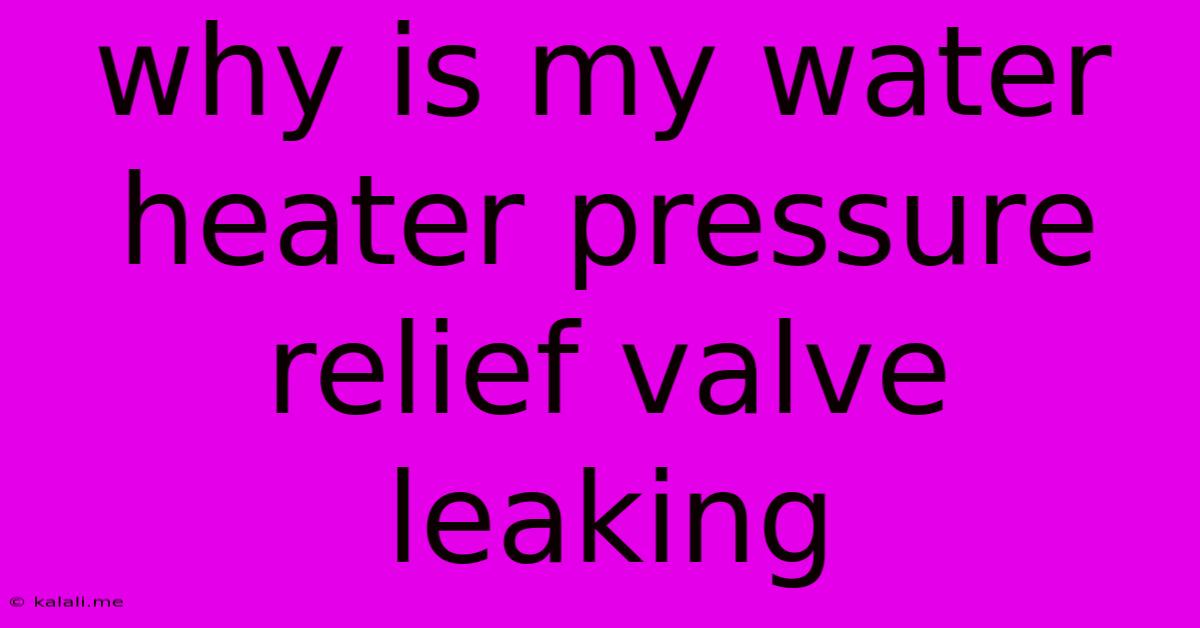Why Is My Water Heater Pressure Relief Valve Leaking
Kalali
Jun 02, 2025 · 3 min read

Table of Contents
Why Is My Water Heater Pressure Relief Valve Leaking? A Troubleshooting Guide
A leaking water heater pressure relief valve can be a frustrating and potentially damaging problem. This article will explore the common causes of this issue, helping you understand why it's happening and what you can do to fix it (or when to call a professional). Ignoring a leak can lead to water damage and even potential safety hazards.
Understanding the Pressure Relief Valve
The pressure relief valve (PRV), also known as a temperature and pressure relief valve (T&P valve), is a crucial safety device on your water heater. Its primary function is to release excess pressure and temperature that could build up inside the tank, preventing dangerous explosions. This pressure can build from several sources, including overheating, a faulty thermostat, or excessive water pressure from your home's plumbing system.
Common Reasons for a Leaking Pressure Relief Valve:
Several factors contribute to a water heater pressure relief valve leak. Here are the most frequent culprits:
1. Excess Water Pressure:
- This is often the primary cause. If your home's water pressure is consistently too high, the PRV will act as a safety mechanism, releasing excess water to alleviate the pressure. A pressure gauge on your main water line can confirm this. You may need a pressure regulator installed to reduce the pressure throughout your home's plumbing system.
2. Temperature and Pressure Build-Up:
- A malfunctioning thermostat can cause the water to overheat, leading to excessive pressure. A failing heating element can also contribute to overheating. If the thermostat is faulty, the water heater will continue to heat the water beyond the set temperature, causing pressure buildup and triggering the PRV.
3. Sediment Buildup:
- Over time, sediment accumulates at the bottom of your water heater tank. This sediment can clog the dip tube, forcing water to heat unevenly and cause pressure fluctuations, leading to the PRV leaking.
4. Faulty or Worn-Out Valve:
- The valve itself might be damaged or worn out from age or constant use. A worn valve might not seal properly, leading to a constant drip. This often manifests as a slow, consistent leak, even with normal water pressure.
5. Expansion Tank Issues (If Applicable):
- Some homes use an expansion tank to mitigate pressure fluctuations. If this tank is malfunctioning or not properly sized, it can fail to absorb pressure surges and instead, force the PRV to release water.
6. Corrosion:
- Over time, corrosion can affect the internal workings of the valve, impairing its sealing ability and leading to leaks.
Troubleshooting and Potential Solutions:
-
Check Your Water Pressure: Use a pressure gauge to measure the water pressure entering your home. If it's consistently above 80 PSI, you likely need a pressure regulator.
-
Inspect the Thermostat: Check your water heater's thermostat for proper operation. If it seems faulty, consider replacing it.
-
Flush the Water Heater: Flushing your water heater removes sediment buildup. This is a relatively simple DIY task, but ensure you follow safety guidelines.
-
Inspect the Dip Tube: If you're comfortable working with plumbing, you can access and inspect the dip tube for damage or blockage.
-
Replace the Pressure Relief Valve: If the valve is old, worn, or damaged beyond repair, replacing it is often the most effective solution. This is relatively simple DIY plumbing; however, if you are unsure it is always best to call a qualified plumber.
When to Call a Plumber:
If you're uncomfortable performing any of the troubleshooting steps above, or if the leak persists after attempting to address the potential issues, it's best to contact a qualified plumber. A professional can accurately diagnose the problem and perform the necessary repairs safely. Ignoring a persistent leak can lead to significant water damage and costly repairs.
By understanding the potential causes of a leaking water heater pressure relief valve and taking proactive steps to address the issue, you can ensure the safety and longevity of your water heater, preventing unnecessary damage and costly repairs. Remember safety is paramount, so always exercise caution when working with plumbing.
Latest Posts
Latest Posts
-
How Many Bugs Have Been Found In Macos
Jun 04, 2025
-
Is It Ever Possible To Get A True Population Sample
Jun 04, 2025
-
Is Puerto Rico Considered International Travel
Jun 04, 2025
-
In The Hope Or In The Hopes
Jun 04, 2025
-
Bloofy First 2d Animated Character In A Pixar Movie
Jun 04, 2025
Related Post
Thank you for visiting our website which covers about Why Is My Water Heater Pressure Relief Valve Leaking . We hope the information provided has been useful to you. Feel free to contact us if you have any questions or need further assistance. See you next time and don't miss to bookmark.